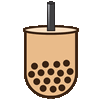From Taiwan to the World
If you’ve ever indulged in a sweet, chewy boba tea, you might have found yourself wondering where this delightful drink came from. Let’s take a journey through the fascinating history of boba, also known as bubble tea or pearl milk tea, and see how it transformed from a local Taiwanese treat to a global phenomenon.
The Beginnings in Taiwan
Boba tea’s origins trace back to Taiwan in the 1980s, where several stories vie for the title of “inventor.” One of the most popular accounts is from the Chun Shui Tang teahouse in Taichung. The story goes that Liu Han-Chieh, the owner, began serving Chinese tea cold after being inspired by cold coffee in Japan. In 1988, Lin Hsiu Hui, the teahouse’s product development manager, poured her tapioca dessert into her tea during a staff meeting. The combination was a hit, leading them to add it to their menu, where it quickly gained popularity.
Another contender for the origin story comes from the Hanlin Tea Room in Tainan. In 1986, Tu Tsong-He, the owner, added white tapioca balls to tea, creating an early version of bubble tea. These white tapioca balls were later replaced with the now-familiar black ones, giving birth to the classic pearl milk tea.
Rising Popularity and Global Spread
Boba tea quickly became a beloved beverage in Taiwan and soon spread to neighboring Asian countries like Japan, China, and across Southeast Asia during the 1990s. Its journey didn’t stop there. By the 2000s, boba tea was making waves in Western countries, notably in the United States, Canada, and Australia. The growing Asian diaspora and cultural curiosity fueled its popularity.
The 2010s saw boba tea exploding into a global trend. Social media platforms played a huge role in this surge, with countless photos and videos of this colorful, photogenic drink captivating people worldwide. Today, dedicated boba shops can be found in nearly every major city, making it a staple of modern urban culture.
Endless Varieties and Innovations
The original boba tea was a simple mix of black tea, milk, sugar, and chewy tapioca pearls. However, creativity knows no bounds, and soon, a variety of flavors and innovations emerged:
- Flavored Teas: From fruity infusions to jasmine and grean teas, there’s a flavor for every palate.
- Milk Alternatives: Options like soy milk, almon milk, and oat milk cater to those who are lactose-intolerant or prefer plant-based diets.
- Toppings Galore: Beyond tapioca pearls, you can now find toppingss like fruit jellies, popping boba filled with fruit juice, aloe versa, and grass jelly.
- Blended and Frozen: Smoothies, slushies, and other blended versions add a refreshing twist to the classic drink.
A Cultural Icon
Boba tea has transcended being just a drink; it’s a cultural icon and a social phenomenon. It perfectly symbolizes the blend of traditional and modern culinary practices. From its humble beginnings in Taiwanese teahouses, boba tea has become a trendy lifestyle beverage embraced by young and old alike.
In Conclusion
The journey of boba tea from Taiwan to the rest of the world is a testament to its delightful appeal and versatility. Whether you’re a long-time fan or new to the boba craze, there’s always something new to discover and enjoy in this ever-evolving drink. So next time you sip on your favorite bubble tea, take a moment to appreciate the rich history and global journey behind those chewy, sweet pearls.


